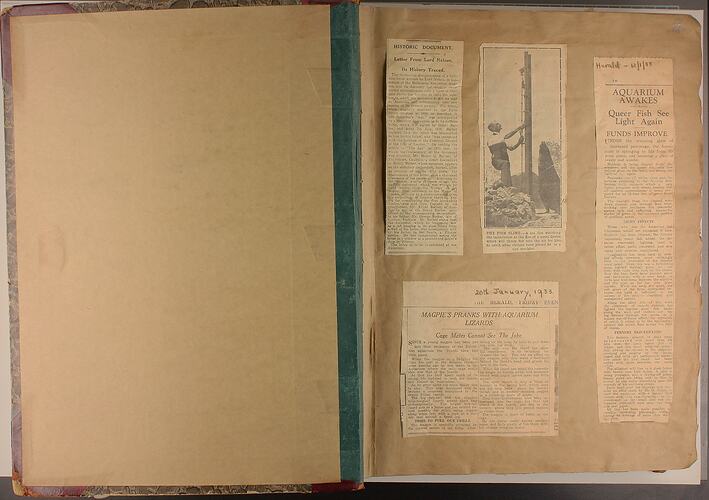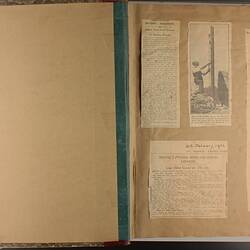Summary
The scrapbook contains newspaper articles and photographs from 1938 to 1955. These not only reflect many social issues of Melbourne at the time but also the challenges faced and triumphs achieved by Isabel during her career.
Overview
Isabel collected a rich and vibrant tapestry of stories relating to the oval and bicycle track, migrant reception centre, the Palais Royale Ballroom, RAAF training centre and White Ensign headquarters. Other articles highlight stoushes between Exhibition Trustees, local and federal government departments, and various community groups. These include water regulations, fire management, car-parking arrangements, office relocation and the ongoing struggles for maintenance funding. From the beginning, Isabel's role involved frequent exhibitions and events and as 'the only female Aquarium and Aviary curator in Australia' she was also keen to establish a 'Playground for Royalty' as well introducing a Women's Exhibition and Children's area (Scrapbook, p. 27).
Exhibitions
A variety of exhibitions took place both in the Great Hall and Aquarium. Some include the International Motor Show (the Scrapbook contains at least one article for every year it was held); the 1946 Children's Week Exhibition (Scrapbook, p.77); the Chemex exhibition of 1947 (Scrapbook, p.78); the Herald Atomic Age Industrial Exhibition held in 1948 (Scrapbook, p.80); the 1948 Modern Homes Exhibition (Scrapbook, p. 109/114); the Australian Aviation Fair held in 1948 (Scrapbook, p.112); and the 1950 Mechanical Show (Scrapbook, p.128).
Events
The building also hosted many events including: the Chinese Carnival, a 1939 fundraiser for Chinese refugees (Scrapbook, p.34); the 1939 Victorian Freemason's 50th anniversary (Scrapbook, p.45); Melbourne's first annual spring Ball held in 1939 (Scrapbook, p 48); the 1949 "Music for the People" event (Scrapbook, p.107/140); the Aquarium party in Aid of Food for Britain event held in 1946 (Scrapbook, p.68), the 1948 Melbourne Catholic Diocesan Centenary (Scrapbook, p.97-99) the State Government's Commonwealth Jubilee Pageant held in 1951 (Scrapbook, p.151); the conversion the 70 year old Exhibition Palais Royale and opening of the "Royale Ballroom" held in 1952 (Scrapbook, p.139); the 1953 "White Ensign" Ball (Scrapbook, p.142); and the Australasian Medical Congress in 1952 (Scrapbook, p.146). There were also events the Trustees refused hire of the building for such as the Peace Congress in 1950 due to its link with Russia's Communist Party and local unions (Scrapbook, p.122).
Through Isabel's collecting we see a mid-20th century insight into the history and cultural heritage not only of the Exhibition Building but of Melbourne itself. Two areas she was particularly passionate about documenting were the Aquarium and the 1954 Royal Visit.
The Aquarium
In October 1940, the Royal Australian Air Force requisitioned the Exhibition Building so Isabel concentrated on promoting the Aquarium. The Aquarium, a popular Melbourne venue, drew thousands of locals and tourists from abroad. Isabel described the Aquarium as her 'pet' and frequently corresponded with experts and curators. The scrapbook contains many articles and photographs relating to the Aquarium's events and the creatures contained within.
In the 1930s Isabel was responsible for installing a 12 tank freshwater tropical section in the aquarium. The tropical area included a section devoted to corals, the first of its kind in Australia ((Scrapbook, p. 209). As part of the development she consulted with staff from Taronga Zoo and explored the natural coastal habitats of Queensland. For the tropical section 450 new fish were collected from national and international locations including Brazil, Dutch East Indies, India, Siam, Guatemala, Singapore, Malay States and Mexico. Species included Great Barrier Reef starfish and coral, fossilised sharks' teeth, lung fish, porcupine fish, cowfish, seahorse, Port Jackson shark, boar fish, Japanese salamander, golden orfe (Germany), Siamese fighting fish, blue and pink gourami, rasbora, blue fin, silver tetra and carpetshark.
One species that did not fare well was the saltwater crocodile. Prior to Isabel's appointment, four crocodiles were caught to be transported from Northern Australia to Melbourne however one was shot, two drowned and one was strangled to death. Percy, a 12ft long male, made it. Unfortunately, he did not thrive in his new environment and died shortly after rehousing.
Aviary and Vivarium
Within the existing rock garden, Isabel also established Australia's first vivarium containing some 500 plants. Isabel also managed what was considered Australia's premier aviary containing an albino magpie, performing cockatoo's, magpies, Elegan's parakeets', tawny frogmouth owls, South African giant wydah, bowerbird, blue crane, parrots and peacocks including an albino peacock (Peter, Biddy & Snowy).
The Aquarium Fire (pp.153-55)
The Aquarium fire took place on the evening of Wednesday 28 January 1953. While the site was extensively damaged, heroic efforts from the Fire Brigade and general public stopped the flames from spreading to the main Building, the Migration centre and Royale Ballroom. There were proposals of rebuilding another Aquarium at St. Kilda after the Trustees decide not to rebuild onsite, however this never eventuated.
1954 Royal Visit (pp. 165 - 200)
Royalty and the [Royal] Exhibition Building have a history dating back to opening of Federal Parliament in 1901. The Queen and Prince Philip visited Victoria from 24 February to 9 March 1954. A year after the Aquarium burned down; Isabel's dream of once again using the Exhibition Building to entertain royalty became reality when state functions for the Queen and the Duke of Edinburgh were held. There were three events for the Royal couple held at the Building: the State Banquet, the Royal Ball and the State Reception.
The State Banquet 28 February 1954 (pp. 165 -174)
After the Royal couple attended a day at the Flemington races and Kooyong tennis, they graced the State Banquet in the Royale Ballroom. Being eleven minutes late and escorted by Premier Cain and the Duke, the Queen dazzled 20,000 well-wishers dressed in a magnolia duchess satin gown with gold and silver palettes and sequins, a white mink stole, stunning jewels and the riband of the Order of the Garter. The Queen also wore Australia's gift of a diamond wattle spray broach and accepted a gold rose bowl while the Duke of Edinburgh accepted a walking cane and cigarette box.
The Banquet menu consisted of: grapefruit maraschino, filet whiting Otero, chicken casserole paysanne, pommes pailles, fresh green peas, tomato farcis served on top of iced asparagus vinaigrette, bombe nasselrode, coffee, devilled almonds, muscatels and glazed sweets. The couple left the event, which was attended by 450 guests, at 10:15pm rather than the expected 11pm. Thousands of well-wishers are disappointed due to their early departure.
The Royal Ball 2 March 1954 (p. 175 - 185)
Each Royal function drew larger and larger crowds, and was colourfully reported in the newspapers. At the £40,000 Royal Ball, the Queen wore a white tulle dress with embroideries while her jewelry consisted of a set of diadem, necklace, earrings and a cabouchon broach of emerald and diamonds and the blue ribbon of the Order of the Garter. The Queen described the Carlton Gardens as stunningly beautiful and commented on Charles Nuttel's opening of Federal Parliament painting claiming she had the original in St. James palace. According to newspaper reports a three year old polio patient was also thrilled when the Duke waved at her twice.
A crowd of 5,000 sang the National Anthem as the Queen arrived at the Building, which was adorned with zinnias, dahlias, phlox, and marigolds. Blue silk drapes hung from the rafters. Red, white and blue silk banners embroidered with royal emblems adorned the walls. Behind the stage was a massive backcloth of Windsor Castle. A dais where the Royal couple sat was situated in the centre of the room and was covered in white drapes and vases of pastel gladioli's. On a white rug sat two cerise brocade gilded chairs for the Queen and Duke. The ballroom is described the largest in the Southern hemisphere containing 70 tables of sucking pig, lobster, squab, turkey, chicken and fried whiting with mixed salad as well as fruit salad and trifle. A band began with "Some Enchanted Evening". Lord Mayor Cr. Solly presented the Queen with a 15ct gold box on behalf of Melbourne. The Royal couple did not dance and despite the size of the Grand Hall, numbers felt uncomfortable with 6,000 people attending the event.
The State Reception 8 March 1954 (pp. 186 -200)
On the evening of 8 March, approximately 8,000 guests attended Melbourne's final reception for the Queen's visit. 500,000 onlookers gathered as the Royal couple's 14 day tour of Victoria ended and they embarked for Queensland. The Queen wore a gown of pearl duchesse satin with cap sleeves and the skirt overlaid with pleated pastel blue tulle. Her jewellery was a high diamond tiara with diamond and pearl necklace and pearl drop earrings. She also wore the blue riband Garter and a maple leaf diamond brooch.
In preparation for the reception 40 men worked for eight days to ensure that 10,000 troughs and tubs of flowers and ferns transformed the Exhibition Building. A 7ft wide 'garden' with blue ageratum, moss, phlox and Gillian Wallace blooms encircling a fountain was installed in front of the dais to stop crowds from massing to see the Queen. The Victorian Symphony Orchestra and a choir of 500 replaced the area where the backdrop of Windsor Castle stood during the Royal Ball. The Girl Guides Association, International Club, National Council for Women, the Y.W.C.A, Housewives Association, and Free Kindergarten Union were also represented. The dais was positioned exactly where her grandfather had opened Parliament in 1901. Premier Cain thanked the Queen and proposed she revisits during the Royal Toast. The menu consisted of a centrepiece which was a three foot mound of green rice, white noodle pasta and lobster. There were also: Cocktails: Oyster and melon (three kinds) Fish: Stuffed and glazed whiting and Poached Murray cod with hollandaise sauce Joints: Sucking pig, lamb beef and ham Poultry: Turkey, capon, duckling, chicken, teal duck Sweets: Pineapple orientale, blackberry flan, petit fours
The scrapbook articles not only vividly describe every frock worn, what was eaten and who behaved badly; they also give an insight into the close relationship between Australia and Britain some 50 years after the Opening of Federal Parliament. The support for the monarchy and British culture is particularly poignant in the articles describing the State Reception.
More Information
-
Keywords
Royal Exhibition Building: History of Events, 1950-1959, Royal Exhibition Building: History of Events, 1900-1949, Royal Exhibition Building: Administration, Royal Exhibition Building Trustees, Royal Visits, Royal Exhibition Building: Fires, Royal Exhibition Building: Aquarium, Museum & Picture Salon
-
Authors
-
Article types

